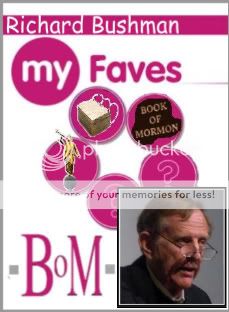"My Faves" on the Book of Mormon - Richard Bushman
In this abbreviated edition of the "My Faves" series, Richard Bushman sent his list of faves along, saying: "I like the following list of articles not because they are the best articles or because I necessarily agree with them, but because they are provocative."
1. Adam S. Miller, “Messianic History: Walter Benjamin and the Book of Mormon,” in James M. McLaughlan and Loyd Ericson, eds., Discourses in Mormon Theology: Philosophical and Theological Possibilities (Salt Lake City: Greg Kofford Books, 2007), 227-246.
2. Blake Ostler, “The Book of Mormon as a Modern Expansion of an Ancient Source,” Dialogue: A Journal of Mormon Thought, Spring 1987: 66-123.
3. Hugh Nibley, "An Auspicious Beginning," An Approach to the Book of Mormon (Salt Lake City: Deseret Book Company, 1964), 33-45.
4. Krister Stendahl, "The Sermon on the Mount and Third Nephi," In Reflections on Mormonism, ed. T. Madsen. Provo, Utah, 1978.
5. Royal Skousen, “Translating the Book of Mormon: Evidence from the Original Manuscript,” in Book of Mormon Authorship Revisited, ed. Noel Reynolds (Provo, 1997).
_____________________________________
Richard Lyman Bushman is Gouverneur Morris Professor of History Emeritus at Columbia University in New York City, and currently occupies the Howard W. Hunter Chair of Mormon Studies at Claremont Graduate University in California. He is also Co-General Editor for the Joseph Smith Papers project of the History Department of the Church of Jesus Christ of Latter-day Saints, and chairs the Board of Directors of the Mormon Scholars Foundation.
1. Adam S. Miller, “Messianic History: Walter Benjamin and the Book of Mormon,” in James M. McLaughlan and Loyd Ericson, eds., Discourses in Mormon Theology: Philosophical and Theological Possibilities (Salt Lake City: Greg Kofford Books, 2007), 227-246.
2. Blake Ostler, “The Book of Mormon as a Modern Expansion of an Ancient Source,” Dialogue: A Journal of Mormon Thought, Spring 1987: 66-123.
3. Hugh Nibley, "An Auspicious Beginning," An Approach to the Book of Mormon (Salt Lake City: Deseret Book Company, 1964), 33-45.
4. Krister Stendahl, "The Sermon on the Mount and Third Nephi," In Reflections on Mormonism, ed. T. Madsen. Provo, Utah, 1978.
5. Royal Skousen, “Translating the Book of Mormon: Evidence from the Original Manuscript,” in Book of Mormon Authorship Revisited, ed. Noel Reynolds (Provo, 1997).
_____________________________________
Richard Lyman Bushman is Gouverneur Morris Professor of History Emeritus at Columbia University in New York City, and currently occupies the Howard W. Hunter Chair of Mormon Studies at Claremont Graduate University in California. He is also Co-General Editor for the Joseph Smith Papers project of the History Department of the Church of Jesus Christ of Latter-day Saints, and chairs the Board of Directors of the Mormon Scholars Foundation.




 2
Comments
2
Comments
